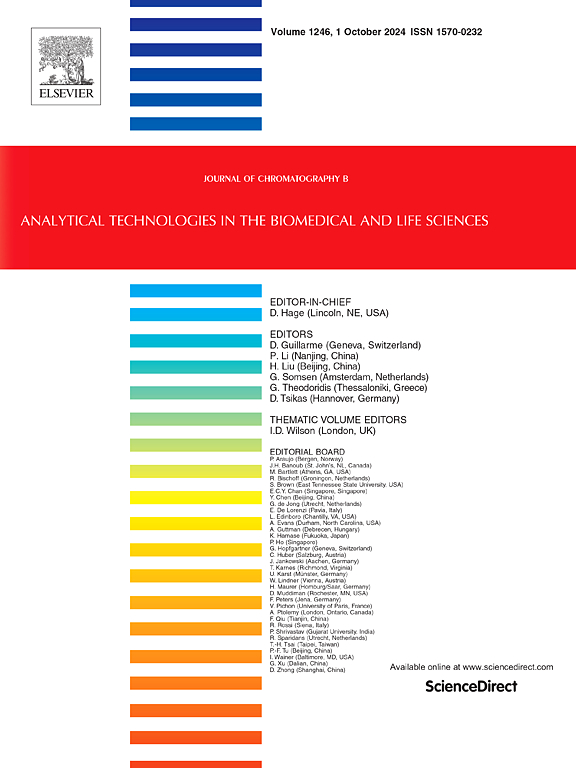Integration of network pharmacology, molecular docking and pharmacokinetic investigations of dandelion in rats for the treatment of diabetes mellitus
IF 2.8
3区 医学
Q2 BIOCHEMICAL RESEARCH METHODS
引用次数: 0
Abstract
Background
The dandelion is a medicinal and edible plant with various assumed properties, including hypoglycemic, antioxidative, anti-inflammatory, and anti-tumor effects. However, the underlying mechanism and metabolic behavior of dandelion that can be used in treating diabetes mellitus (DM) remain unclear.
Aims
This study aimed to investigate the molecular mechanism of dandelion in the treatment of DM and the in vivo metabolic behavior of its bioactive components.
Methods
Network pharmacology and molecular docking were used to identify the underlying mechanism of dandelion in treating DM. LC-MS/MS was used to analyze the pharmacokinetic behavior of the main active components in dandelion in rats.
Results
The network pharmacology analysis demonstrated that the primary active components (hesperidin, protocatechuic acid, and syringic acid) of dandelion exert therapeutic effects on DM through multi-target interactions. These components regulated lipid and atherosclerosis pathways and the AGE-RAGE signaling pathway in diabetic complications via interactions with core targets including SRC, HRAS, and AKT1. The highest and lowest docking scores were − 8.55792 kcal·mol−1 and -4.18450 kcal·mol−1, respectively, indicating good binding activity between the compounds and the targets. Pharmacokinetic analysis revealed that all the analytes were detected in the plasma but their elimination within 24 h varied. Hesperidin, syringic acid and protocatechuic acid are abundant in rat plasma, characterized by extended long half-life and high bioavailability.
Conclusion
This work not only predicted the potential mechanism of dandelion in treating DM, but also revealed the pharmacokinetic profiles of its active components, a finding that is critical for advancing clinical applications of dandelion and related traditional Chinese medicine (TCM) formulae.

蒲公英治疗糖尿病的网络药理学、分子对接及大鼠药代动力学研究
蒲公英是一种药用和可食用的植物,具有多种特性,包括降血糖、抗氧化、抗炎和抗肿瘤作用。然而,蒲公英治疗糖尿病(DM)的潜在机制和代谢行为尚不清楚。目的探讨蒲公英治疗糖尿病的分子机制及其生物活性成分的体内代谢行为。方法采用网络药理学和分子对接方法,研究蒲公英治疗糖尿病的作用机制,采用LC-MS/MS分析蒲公英主要有效成分在大鼠体内的药动学行为。结果网络药理学分析表明,蒲公英的主要活性成分橙皮苷、原儿茶酸和丁香酸通过多靶点相互作用发挥对糖尿病的治疗作用。这些成分通过与包括SRC、HRAS和AKT1在内的核心靶点相互作用,调节糖尿病并发症中的脂质和动脉粥样硬化途径以及AGE-RAGE信号通路。最高和最低的对接分数分别为- 8.55792 kcal·mol−1和-4.18450 kcal·mol−1,表明化合物与靶标具有良好的结合活性。药代动力学分析显示,所有分析物均在血浆中检测到,但其在24 h内的消除有所不同。大鼠血浆中含有丰富的橙皮苷、丁香酸和原儿茶酸,具有半衰期长、生物利用度高的特点。结论本研究不仅预测了蒲公英治疗糖尿病的潜在机制,而且揭示了蒲公英有效成分的药动学特征,对推进蒲公英及相关中药方剂的临床应用具有重要意义。
本文章由计算机程序翻译,如有差异,请以英文原文为准。
求助全文
约1分钟内获得全文
求助全文
来源期刊

Journal of Chromatography B
医学-分析化学
CiteScore
5.60
自引率
3.30%
发文量
306
审稿时长
44 days
期刊介绍:
The Journal of Chromatography B publishes papers on developments in separation science relevant to biology and biomedical research including both fundamental advances and applications. Analytical techniques which may be considered include the various facets of chromatography, electrophoresis and related methods, affinity and immunoaffinity-based methodologies, hyphenated and other multi-dimensional techniques, and microanalytical approaches. The journal also considers articles reporting developments in sample preparation, detection techniques including mass spectrometry, and data handling and analysis.
Developments related to preparative separations for the isolation and purification of components of biological systems may be published, including chromatographic and electrophoretic methods, affinity separations, field flow fractionation and other preparative approaches.
Applications to the analysis of biological systems and samples will be considered when the analytical science contains a significant element of novelty, e.g. a new approach to the separation of a compound, novel combination of analytical techniques, or significantly improved analytical performance.
 求助内容:
求助内容: 应助结果提醒方式:
应助结果提醒方式:


